Pro1 T731WO Bedienungsanleitung
Pro1
Thermostat
T731WO
Lies die bedienungsanleitung für Pro1 T731WO (5 Seiten) kostenlos online; sie gehört zur Kategorie Thermostat. Dieses Handbuch wurde von 3 Personen als hilfreich bewertet und erhielt im Schnitt 3.8 Sterne aus 2 Bewertungen. Hast du eine Frage zu Pro1 T731WO oder möchtest du andere Nutzer dieses Produkts befragen? Stelle eine Frage
Seite 1/5

T731W(O)
Installation Manual
Pro1 Technologies
Toll Free : 888-776-1427
Web: www.pro1iaq.com
Hours of Operation: M-F 9AM - 6PM Eastern
Thermostat Application Guide
Description
Gas or Oil Heat
Electric Furnace
Heat Pump (No Aux. or Emergency Heat)
Heat Pump (With Electric Aux.)
Multi-Stage Systems
Heat Only Systems - Floor or Wall Furnace
Cool Only Systems
Millivolt
Yes
Yes
Yes
Yes
No
Yes
Yes
Yes
Yes
Power Type
Battery Power
Hardwire (Common Wire)
Hardwire (Common Wire) with
Battery Backup
Table of Contents
Installation Tips
Thermostat Quick Reference
Base Module Mounting Tips
Wiring
Technician Setup
Establishing Communication
Network Specications
Specications
Page
A trained, experienced
technician must install this
product.
Carefully read these
instructions. You could damage
this product or cause a
hazardous condition if you fail
to follow these instructions.
Una version en español de este
manual se puede descargar en
la pagina web de la compañia.
Rev. 2132
Mount Thermostat
Align the 4 tabs on the subbase
with corresponding slots on the
back of the thermostat, then push
gently until the thermostat snaps
in place.
Battery Installation
Battery installation is
optional if thermostat is
hardwired (R and C terminal
connected to 24V power).
Important:
High quality alkaline batteries are recommended.
Rechargeable batteries or low quality batteries
do not guarantee a 1-year life span.
Insert 2 AA
Alkaline batteries
(included). High
quality alkaline
batteries are
recommended.
Installation Tips
2
2
2
2
4-5
8-11
12-16
1
1
1
1
2-3
Installation Tips Thermostat Quick Reference
Getting to know your thermostat
3
3
3
3
4
4
4
4
Subbase Installation
The thermostat should be installed approximately 4 to 5 feet above the
oor. Select an area with average temperature and good air circulation.
• Close to hot or cold air ducts
• That are in direct sunlight
• With an outside wall behind
the thermostat
• In areas that do not require
conditioning
• Where there are dead spots
or drafts
(in corners or behind doors)
• Where there might be
concealed chimneys or
pipes
Wall Locations
Vertical Mount
Horizontal Mount
For vertical mount put one screw on the top
and one screw on the bottom.
For horizontal mount put one screw on the
left and one screw on the right.
All of our products are mercury free.
However, if the product you are
replacing contains mercury, dispose of
it properly. Your local waste
management authority can give you
instructions on recycling and proper
disposal.
Pick an installation location that is easy for
the user to access. The temperature of the
location should be representative of the
building.
Installation Tip
Mercury Notice
Do not install
thermostat in locations:
Failure to disconnect the power before
beginning to install this product can
cause electrical shock or equipment
damage.
Installation Tip:
Electrical Hazard
U.S. Registered Trademark. Patents pending
Copyright 2020 All Rights Reserved.
Heat Pump (With Gas Aux.)
Emergency Heat
Conventional Single Stage Furnace
Geothermal
High, Medium and Low Fan Speed
No
No
Yes
Yes
19
Located on the back of thermostat.
P.O. Box 3377
Springeld, MO 65808-3377
Glow in the Dark Light Button
Setpoint Buttons
LCD
System Button
Fan Button
R
17-18
20
6-7
Occupancy Sensor
(Occupancy Model Only)

5
5
5
5
6
6
6
6
Base Module - PTAC Installation
Side Mount:
Inside PTAC
Housing
Front Mount:
Inside PTAC
Housing
Base Module Mounting Tips
Range between the thermostat and the base module is up to 100 feet
with no obstructions and up to 50 feet through standard building
materials. To optimize the range try placing the base module with no
metal between it and the thermostat.
The base module is designed to be mounted behind the front grille
of a packaged terminal air conditioner (PTAC). Refer to the PTAC
manufacturer’s manual for instruction to remove the front grille.
Check clearance to ensure the t of front grille after base module
installation. See below for a few location recommendations.
The low battery indicator is displayed when the AA battery power is low. If the user
fails to replace the battery within 21 days, the screen will only show the low battery
indicator but maintain all functionality. If the user fails to replace the batteries after
an additional 21 days (days 22-42 since rst “low battery” display) the setpoints will
change to 55˚F (Heating) and 85˚F (Cooling). If the user adjusts the setpoint away from
either of these, it will hold for 4 hours then return to either 55˚F or 85˚F. After day 63
the batteries must be replaced immediately to avoid freezing or overheating because
the thermostat will shut the unit o until the batteries are changed.
Important
Ambient Temperature:
Displays the current room temperature
Energy Ecient Globe:
Indicates you are making an energy ecient set at
temperature.
Staging Indicaators:
If these or the fan indicators are ashing, it means that the system is in a delay of some
type (compressor delay, cooling fan delay, or staging delay) or a pending change.
Set At Temperature:
Displays the selected desired room temperature.
Wireless Symbol: Indicates you have a wireless connection.
1
2
3
Next
Heat
Cool
Prev
Auto
On LHM
Set At
COOL ON
HEAT ON
FAN ON
STAGE 1+2
Next
Heat
Cool
Prev
Auto
On LHM
Set At
COOL ON
HEAT ON
FAN ON
STAGE 1+2
Thermostat Quick Reference
Low Battery Indicator: Replace batteries when this indicator
appears.
1
2
3
Base Module Mounting Tips
7
7
7
7
Wiring
8
8
8
8
When Working With A Vertical Unit
1. Do not mount Module inside the cabinet of the unit, or in a
metal enclosure.
2. Mount on the outside of the unit to maximize wireless
communication.
When Working With A Metal Sleeve Cabinet, Room Cabinet,
or PTAC Cover
1. If cabinet has open bottom, mount the module just inside the
cabinet as close to the open bottom as possible without placing it in
danger of being bumped or touched by furnishings, vaccum, etc.
2. Another good module location would be on the underside of the
top of the cabinet or cover. Directly behind the open Louver/Grill.
Front Panel
Chasis
Sleeve Cabinet
Rough-In
Wall Opening
Caution:
Electrical Hazard
All components of the
control system and the
thermostat installation must
conform to Class II circuits
per the NEC Code.
Warning:
Do not overtighten terminal
block screws, as this can
damage the terminal block.
A damaged terminal block
can keep the thermostat
from tting on the subbase
correctly or cause system
operation issues.
Installation Tip
Max Torque = 6in-lbs.
Wiring
If you are replacing a thermostat,
make note of the terminal
connections on the thermostat
that is being replaced. In some
cases the wiring connections will
not be color coded. For example,
the green wire may not be
connected to the G terminal.
Loosen the terminal block
screws. Insert wires then
retighten terminal block screws.
Place nonammable insulation
into wall opening to prevent
drafts.
1.
2.
3.
Terminal Designations
R
Failure to disconnect the power
before beginning to install this
product can cause electrical
shock or equipment damage.
C
B
O
GL
Heat Pump System
1 HEAT 1 COOL / 2 HEAT 1 COOL
Conventional System
1 HEAT 1 COOL
Transformer Power
Transformer Common
Changeover Valve
Energized in HEAT
Fan Relay, Low
Changeover Valve
Energized in COOL
Second Stage of HEAT
First Stage of HEAT and COOL
Transformer Power
Transformer Common
Fan Relay, Low
First Stage of HEAT
First Stage of COOL
N/A
N/A
GH
W
Y
Fan Relay, High Fan Relay, High

Wiring Technician Setup
11
11
11
11
12
12
12
12
Cooling
Swing
Tech Setup Steps
Adjustment Options Default
LCD Will Show
Room
Temperature
Calibration
This feature allows the installer to
change the calibration of the am-
bient room temperature display.
For example, if the thermostat
reads 70 degrees and you would
like it to read 72 then select +2.
0˚F
4 ˚ - -4 ˚
9
9
9
9
10
10
10
10
Caution:
Electrical Hazard
All components of the control
system and the thermostat
installation must conform to
Class II circuits per the NEC Code.
Warning:
Failure to disconnect the power
before beginning to install this
product can cause electrical
shock or equipment damage.
Power supply
Typical 1H/1C System: 2 Speed Fan
Wiring Wiring
The base module is
packaged with labeled
thermostat wire. Wire
appropriately into the
PTAC board terminals.
Wiring Note:
The thermostat and Base Module
come factory linked (communicating)
out of the box. However, if the link is
lost, use the process on page 14 to
re-link the devices.
Note:
The base module may be mounted
using adhesive tape, such as
double-sided tape or hook and loop
strips. The base module must be
hardwired (C & R terminals
connected to 24V power). Use
secondary source of securement to
prevent module from dropping into
condenser drain pan.
Note:
Connecting to a PTAC:
When connecting the Base Module
to a PTAC, refer to the PTAC
manufacturer instructions to enable
remote thermostat operation.
R
Y
W
C
GL
GH
COMPRESSOR
RELAY
HEAT RELAY
FAN LOW RELAY
FAN HIGH RELAY
C
R
L2
L1
Typical 1H/1C System: 1 Speed Fan
R
Y
W
C
GL
GH
HEAT RELAY
FAN RELAY
COMPRESSOR
RELAY
Typical 1H/1C Heat Pump System: 2 Speed Fan
R
Y
W
C
GL
GH
COMPRESSOR
RELAY
FAN LOW RELAY
FAN HIGH RELAY
C
R
L2
L1
C
R
L2
L1
Typical 2H/1C Heat Pump System: 2 Speed Fan
C
R
L2
L1
COMPRESSOR
RELAY
AUX HEAT
RELAY
FAN LOW RELAY
FAN HIGH RELAY
CALIBRATE
The swing setting, often called
“cycle rate”, “dierential” or “antic-
ipation” is adjustable and dictates
how frequenlty the system cycles
on and o. For example: A swing
setting of 0.8˚ will turn the
heating on at approximately 0.8˚
below the setpoint and turn the
heating o at approximately 0.5˚
above the setpoint.
1. To enter Tech Setup Menu, press and hold and together for 3 seconds.
2. Use or to select the desired valve for each setting.
3. Tap previous or next to select dierent tech settings.
4. To exit Tech Setup Menu, press and hold and together for 3 seconds
or wait 60 seconds.
COOL CHANGE
OVER VALVE
HEAT CHANGE
OVER VALVE
O
B
COOL CHANGE
OVER VALVE
HEAT CHANGE
OVER VALVE
O
B
The swing setting, often called
“cycle rate”, “dierential” or “antic-
ipation” is adjustable and dictates
how frequenlty the system cycles
on and o. For example: A swing
setting of 0.8˚ will turn the
cooling on at approximately 0.8˚
above the setpoint and turn the
cooling o at approximately 0.8˚
below the setpoint.
0.2 ˚ - 2 ˚
0.8˚
Heating
Swing
0.2 ˚ - 2 ˚
0.8˚
R
C
B
O
GLGH
W
Y
0.8
COOL
SWING
0.8
HEAT SWING
1. Tech settings must be transferred to the basemodule.
2. The transfer happens automatically when you exit the tech menu.
Important Tech Setting Notes
The thermostat must be set to O or B to match the changeover
valve, O is the cool changeover valve, B is the heat chageover
valve.
The Aux. Heat Relay is energized as the second stage of heat.
Thermostat Wiring Tips
C Terminal
The C (common wire) terminal does
not have to be connected when the
thermostat is powered by batteries.
Wire Specications
Use shielded or non-shielded
18-22 gauge thermostat wire.
Most PTAC systems support two speed fan operation. In a single speed
fan PTAC system or conventional single speed fan system, the GL terminal
will be used and “I” must be selected in the Technician Setup Menu.
Note:
0
Produktspezifikationen
| Marke: | Pro1 |
| Kategorie: | Thermostat |
| Modell: | T731WO |
Brauchst du Hilfe?
Wenn Sie Hilfe mit Pro1 T731WO benötigen, stellen Sie unten eine Frage und andere Benutzer werden Ihnen antworten
Bedienungsanleitung Thermostat Pro1
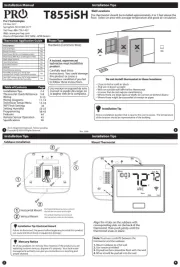
21 August 2025

21 August 2025
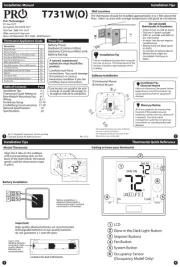
20 August 2025

20 August 2025
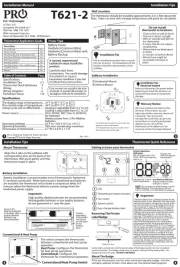
20 August 2025
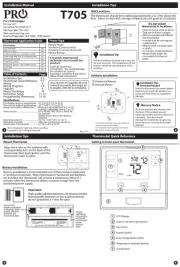
20 August 2025
Bedienungsanleitung Thermostat
- Conrad
- Schneider
- Rose LM
- SilverCrest
- UPM
- Ariston Thermo
- Elco
- Hunter
- Westfalia
- Homematic IP
- Magnum
- Wallair
- Levica
- Vimar
- Cotech
Neueste Bedienungsanleitung für -Kategorien-

21 August 2025
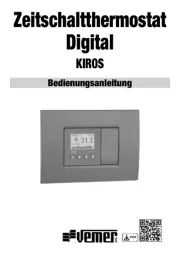
21 August 2025
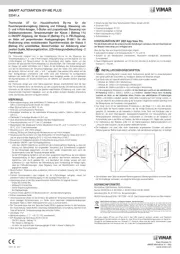
20 August 2025
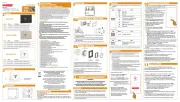
20 August 2025
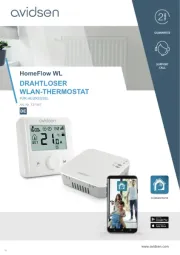
20 August 2025
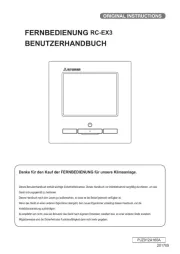
19 August 2025
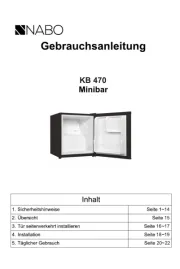
18 August 2025

14 August 2025
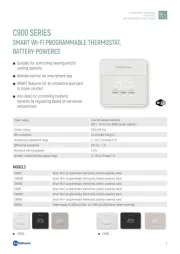
13 August 2025
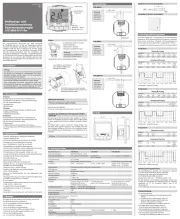
12 August 2025